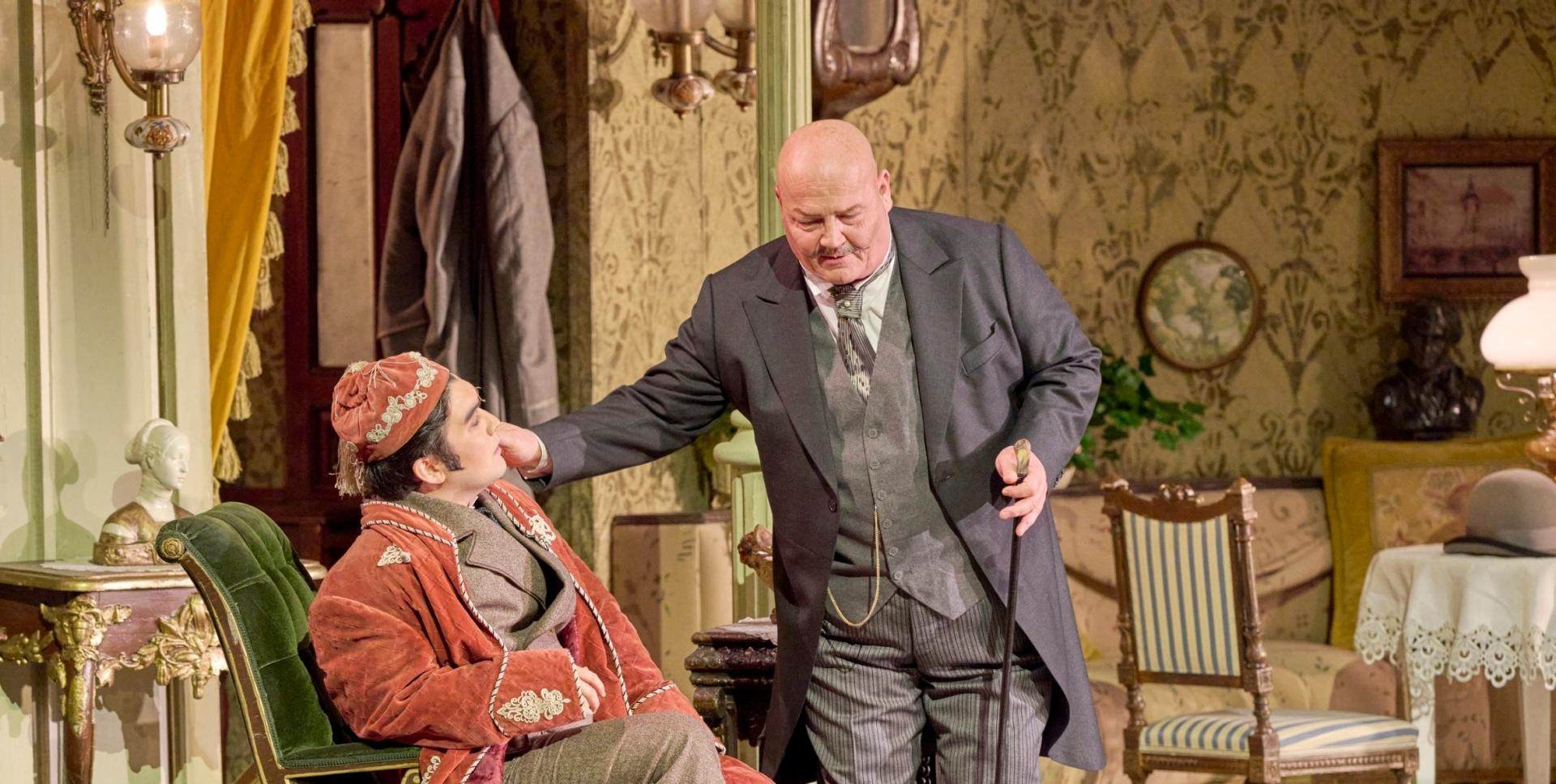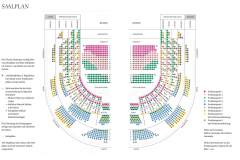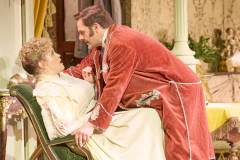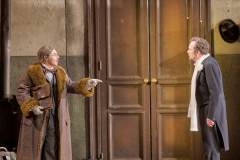Die Fledermaus - The Bat
Mo | Tu | We | Th | Fr | Sa | Su |
ACT 1
The plot revolves around the ball at Prince Orlofsky's. All the characters in Act 1 are magnetically drawn to it, with the exception of Alfred, the tenor in love with Rosalinde, who wanders comet-like on the fringes of the action:
The parlour maid Adele is invited there, as she believes, by her sister Ida and has to invent a touching story about a sick aunt in order to get out after some toing and froing, and her brother, the reindeer Eisenstein, is persuaded by his friend Dr. Falke persuades him to have fun with him at Orlofsky's instead of serving a prison sentence he has been given for insulting an official - of course, Dr. Falke is following his own plan, as Eisenstein once embarrassed him in front of the whole town when he let him walk home drunk and dressed as a bat after a masked ball.
Falke now sees the opportunity for revenge. That is why he also invites Eisenstein's wife Rosalinde to the ball at the end. She is thrown into considerable confusion beforehand when, after Eisenstein's supposed departure to prison, her former admirer Alfred appears, presses her heart, but is arrested by prison warden Frank in Eisenstein's place. After this official act, Frank goes to the ball at Orlofsky's, satisfied.
ACT 2
At Prince Orlofsky's ball, all the entanglements arranged by Dr. Falke work out for the best.
To his amazement, Eisenstein meets his maid Adele, who cheekily denies her identity, makes friends with the prison warden and finally falls in love with his own wife, who is dressed and masked as a Hungarian countess.
ACT 3
Act 3 unties the knots again. It takes place in the prison, which is given a dubious touch by the bailiff Frosch, who is never sober. Everyone arrives there one by one:
after the hungover warden Frank, first Adele, who is looking for a patron to train her dramatic talent, along with her sister Ida, then Eisenstein, who learns to his astonishment that he has already been locked up all night.
When Rosalinde also appears and, together with the arrested Alfred, demands a meeting with a notary, Eisenstein takes the place of the notary Dr. Blind in disguise and thus discovers the events of the previous evening. Fortunately, he is eventually persuaded that these were also part of Dr. Falke's revenge plan, and so everything turns out well, all the more so when Adele actually finds her patron in Prince Orlofsky.
ACT 1 - 50 MIN
INTERMISSION - 25 MIN
ACT 2 - 55 MIN
INTERMISSION - 25 MIN
ACT 3 - 50 MIN
Program and cast
Gabriel von Eisenstein: Georg Nigl
Rosalinde: Hanna-Elisabeth Müller
Frank: Wolfgang Bankl
Prinz Orlofsky: Daria Sushkova
Alfred, ein Tenor: Jörg Schneider
Dr. Falke: Clemens Unterreiner
Adele: Ilia Staple
Frosch: Michael Niavarani
Musical direction: Bertrand de Billy
Direction: Otto Schenk
Stage: Günther Schneider-Siemssen
Costumes: Milena Canonero
Choreography in the 2nd act "Under Thunder and Lightning": Gerlinde Dill
Vienna State Opera
Public Transport
Subway lines: U1, U2, U4
Trams: 1, 2, D, J, 62, 65
Buses: 59A
Local Railway: Badner Bahn
Stops: Karlsplatz / Opera
Taxi stands are available nearby.
Parking
Parking is only € 6, - for eight hours!
The Wiener Staatsoper and the ÖPARK Kärntner Ring Garage on Mahlerstraße 8, under the “Ringstraßengalerien”, offer the patrons of the Vienna State Opera a new, reduced parking fee. You can park in the Kärntner Ring Garage for up to 8 hours and pay only a flat fee of € 6, -. Just validate your ticket at one of the discount machines inside the Wiener Staatsoper. The normal rate will be charged for parking time greater than 8 hours. The validation machines can be found at the following coat checks: Operngasse, Herbert von Karajan-Platz, and the right and left and balcony galleries.
Important: In order to get the discount, please draw a ticket and do not use your credit card when entering the garage!
After devaluing your ticket in the Wiener Staatsoper you can pay comfortably by credit card or cash at the vending machines.
The machines accept coins and bills up to 50.- Euro. Parking time longer than 8 hours will be charged at the normal rate.
History
The structure of the opera house was planned by the Viennese architect August Sicard von Sicardsburg, while the inside was designed by interior decorator Eduard van der Nüll. It was also impacted by other major artists such as Moritz von Schwind, who painted the frescoes in the foyer, and the famous "Zauberflöten" (“Magic Flute”) series of frescoes on the veranda. Neither of the architects survived to see the opening of ‘their’ opera house: the sensitive van der Nüll committed suicide, and his friend Sicardsburg died of a stroke soon afterwards.
On May 25, 1869, the opera house solemnly opened with Mozart's Don Giovanni in the presence of Emperor Franz Joseph and Empress Elisabeth.
The popularity of the building grew under the artistic influence of the first directors: Franz von Dingelstedt, Johann Herbeck, Franz Jauner, and Wilhelm Jahn. The Vienna opera experienced its first high point under the direction of Gustav Mahler. He completely transformed the outdated performance system, increased the precision and timing of the performances, and also utilized the experience of other noteworthy artists, such as Alfred Roller, for the formation of new stage aesthetics.
The years 1938 to 1945 were a dark chapter in the history of the opera house. Under the Nazis, many members of the house were driven out, pursued, and killed, and many works were not allowed to be played.
On March 12, 1945, the opera house was devastated during a bombing, but on May 1, 1945, the “State Opera in the Volksoper” opened with a performance of Mozart's THE MARRIAGE OF FIGARO. On October 6, 1945, the hastily restored “Theaters an der Wien” reopened with Beethoven's FIDELIO. For the next ten years the Vienna State Opera operated in two venues while the true headquarters was being rebuilt at a great expense.
The Secretary of State for Public Works, Julius Raab, announced on May 24, 1945, that reconstruction of the Vienna State Opera would begin immediately. Only the main facade, the grand staircase, and the Schwind Foyer had been spared from the bombs. On November 5, 1955, the Vienna State Opera reopened with a new auditorium and modernized technology. Under the direction of Karl Böhm, Beethoven’s FIDELIO was brilliantly performed, and the opening ceremonies were broadcast by Austrian television. The whole world understood that life was beginning again for this country that had just regained its independence.
Today, the Vienna State Opera is considered one of the most important opera houses in the world; in particular, it is the house with the largest repertoire. It has been under the direction of Dominique Meyer since September 1, 2010.
Performances: Mo 19 May 2025, 11:00
Performances: Sa 01 Feb 2025, 07:15
Performances: We 11 Jun 2025, 19:00
Performances: We 15 May 2024,
Performances: Fr 23 May 2025, 19:00
Performances: Th 13 Jun 2024,

 EN
EN DE
DE IT
IT FR
FR ES
ES RU
RU JP
JP RO
RO
 Seating plan
Seating plan 







